~~~~~~~~~~~~~~~~~~~~~~~~~~~~~~~~~~~~~~
AIA Peconic Daniel J. Rowen Design Awards / 2022
~~~~~~~~~~~~~~~~~~~~~~~~~~~~~~~~~~~
DOES PROJECT ADDRESS ISSUES
OF TIME AND PLACE?
————–
THE CATEGORIES
-----
ARCHITECTURE
The Architecture Awards celebrate outstanding architecture regardless of project size, budget, style, or building type. New buildings and major additions are eligible.
—–
HISTORIC PRESERVATION / ADAPTIVE REUSE
The Historic Preservation/ Adaptive Reuse Awards acknowledge projects that restore, remodel, preserve or repurpose existing buildings of any type or style.
—–
PROJECTS
The Projects Awards recognize unbuilt architecture, planning, urban design, and research. Submissions may be real or conceptual but must reflect a solution related to the built environment.
—–
HONOR AWARD
The project displays clear excellence in architectural design from concept through completion.
—–
MERIT AWARD
The project displays exemplary execution of design principles and presentation.
—–
JUROR AWARD
Recognizes excellence in resolving specific programmatic desires through interpretation of style, technologies, sustainability, materials, and/or vernacular influences. Juror awards are left up to the jury’s discretion and can awarded for any project in any category.
~~~~~~~~~~~~~~~~~~~~~~
2022 Awards
——-
—————– Honor Award / Architecture —————–
Stony Hill | Bates Masi + Architects
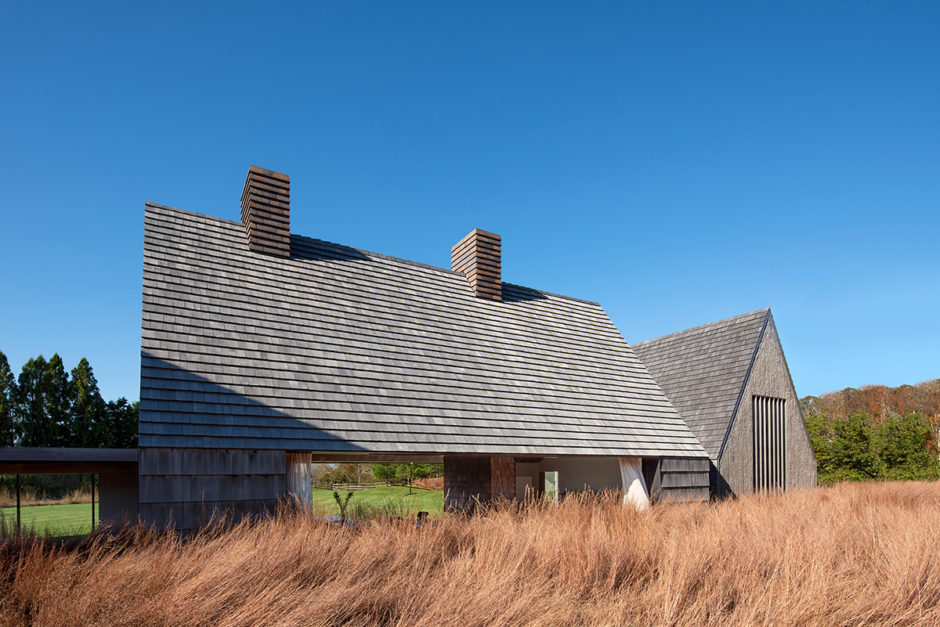
This home for a young family is located in Amagansett, an early English and Dutch settlement on the East End of Long Island. The pastoral site, at the border between meadow and woodland, was first cleared by Native Americans as hunting grounds. Later it became the site of the first house built by a settler in 1680. Most significantly, it served as communal grazing pasture for the early settlers as the town was established alongside it. The meadow was divided into parcels with low stone walls and farmers rotated their livestock from one parcel to the next so as not to overgraze and damage any one area. This synergy among the land, livestock, and human intervention stabilized the landscape for generations. Recently, however, farming has declined as land values have increased, and grazing is no longer managing the meadow. Thus it is slowly transitioning to woodland and its connection to a significant piece of its history is fading.
The goal of the project was to reference the agrarian history of the site in the architecture and landscape design, principally by dividing the site into zones in a similar fashion to the original pasture parcels. In the same way that the parcels had different maturities of grasses due to the rotating grazing, the scale and density of the plantings in each zone were designed to vary based on modern needs: high grasses and shrubs provide a visual and acoustic buffer from the road, medium height grasses screen the house from the approach, and low grass and ground-cover open up views where appropriate. To emphasize the historic connections to the pasture, the planting zones that line the approach are elevated, bringing the grasses to eye level along the entry walk for a unique experience passing through them.
The massing of the house is broken up into smaller volumes, each of which relate to one of the landscape zones: public spaces, private spaces, and guest or service spaces. The interconnected gabled structures reference the connected barn vernacular precedent but are adapted for a modern experience. The steep roof pitches allow for ample 2nd floor space uninterrupted by collar ties. These traditional gable forms are subverted by cuts through the ridge to bring in natural light.
In the same way traditional forms are adapted, so too are historic materials transformed. The shingle siding common to the region is exaggerated in scale. In reference to the grasses of the pasture, traditional thatch siding is employed but it is packed neatly between the exposed exterior framing in a modern interpretation. The rhythm of the exterior framing is continued on the interior in the structure of the stair and the bath vanities. The exterior siding and paving are carried through the breezeways that connect the volumes of the house, further integrating the house with the site. Natural materials including oak, clay tiles, and plaster reinforce a connection to the landscape and a mood of warmth and comfort in the home. The gracious public spaces are each centered around oversized fireplaces to celebrate the family gathering together.
With its holistic approach to both architecture and landscape, the design translates the history of the place into a unique architectural vocabulary. In the process it preserves the pastoral character of the site, creates a record of the past, and enriches the family’s home with deeper meaning.
————————
—– Project Credits Below —–
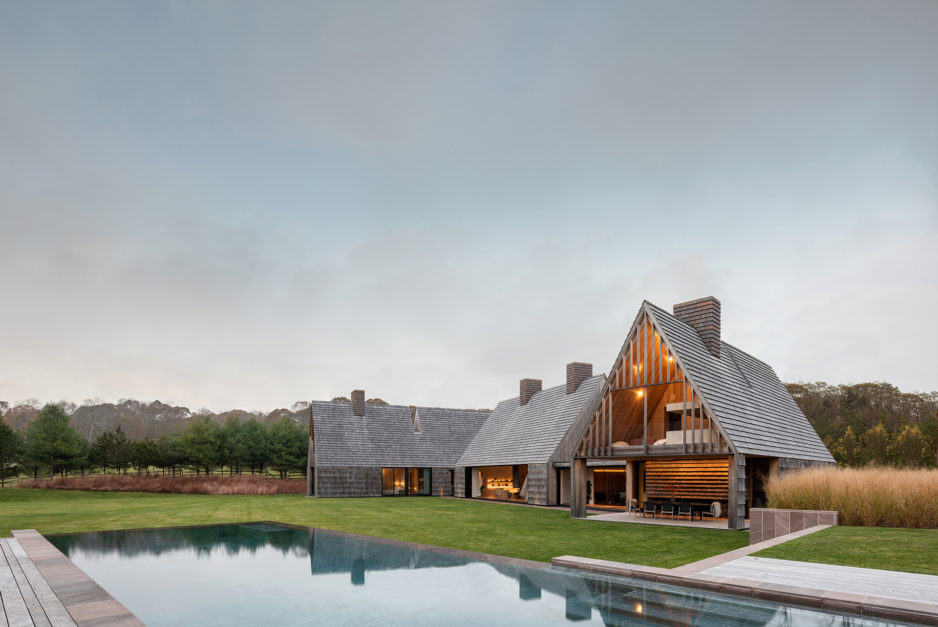
~~~~~~~~~~~~~~~~~~~~~~
—————– Honor Award / Architecture —————–
Lilla Lane | Oza Sabbeth Architects
~~~~~~~~~~~~~~~~~~~~~~
—————– Honor Award / Historic Preservation / Adaptive Reuse —————–
Tolan House | Martin Architects
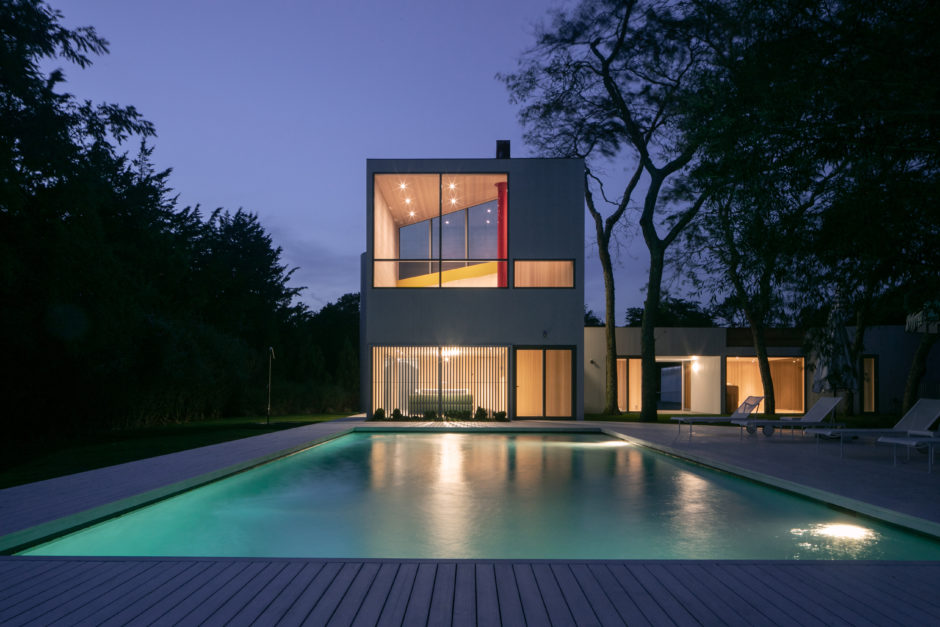
Nestled in the heart of Amagansett sits a Charles Gwathmey-designed house. A short stroll from the ocean, this house sits next door to the famous structure he designed for his parents. A historic landmark in its own right, the goal of this project is to preserve Gwathmey’s vision for the house, while engendering in it a reimagined scope that brims with a modern energy.
In keeping with Gwathmey’s material palette, we have contributed the use of finishes that define his style like the interplay between cedar, stone, glass, and steel, but have expanded it further to include newer materials not available when he first designed the house. We have introduced channel glass, rain screening, and concrete floors. In doing so, we aim to enhance and embody the character of the house. Through careful detailing, we reduce the potential for awkward connections and underscore the beauty of the home’s mid-century scale and form.
We made it a point to embrace the original grid on which Gwathmey designed the house. Doing so, we were able to add to the home’s an indoor-outdoor spa, equipped with translucent infrared sauna and cryogenic plunge pool, all clad in Gwathmey’s signature Dal square tile to the home’s program. To enhance the connection from the outdoor pool to the tennis court beyond, we opened the structure with a central breezeway. Additional door and window openings in the main structure were made and then clad in an elegant rainscreen.
Throughout the house, the interiors are crafted in wood and tile in the same manner as the original, but with a focus on passive and active green practices. The overall result is a celebration of Gwathmey’s genius. The materiality and scope of work strive to highlight his masterful attention to detail and livability in residential architecture.
————————

—– Project Credits Below —–

~~~~~~~~~~~~~~~~~~~~~~~
—————– Merit Award / Architecture —————–
Napeague | Bates Masi + Architects
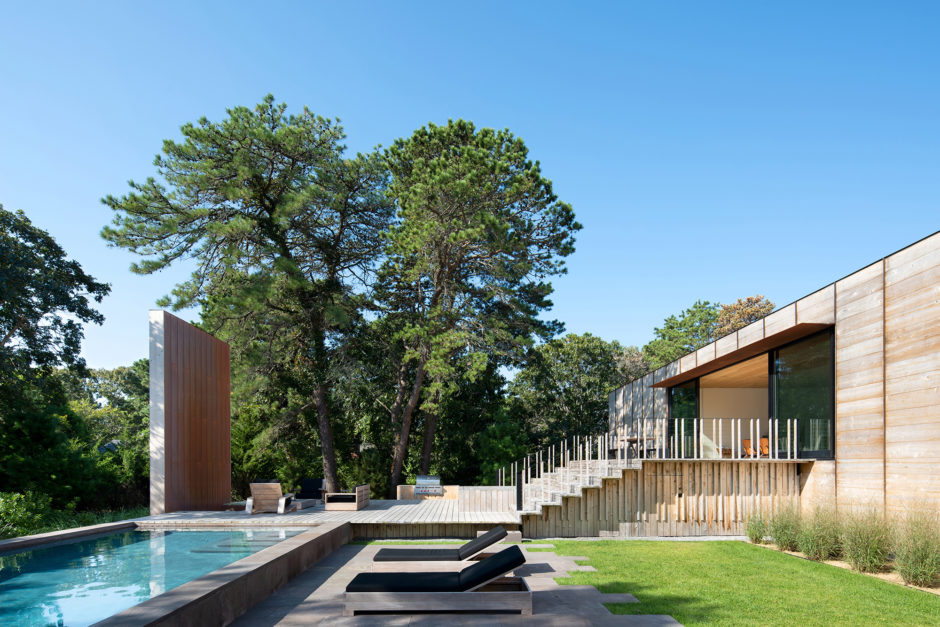
In the early postwar period twenty-five small, simple, low-slung cottages were nestled into the ocean dunes, founding an unpretentious enclave popular with surfers and beach lovers. In ensuing years the community became a gateway to points east, leading to increased traffic on the main highway and railroad that pass along its northern edge. At the same time improved environmental awareness has brought attention to the risks of flooding from hurricanes that periodically inundate these lowlands.
Road and rail traffic noise present the most pressing problem on this highway-fronting lot. Though it may seem paradoxical at first, the new house actually lies closer to the road than its predecessor. However this arrangement, with the structure stretched across the property, shields a large back yard from offending noise and opens it up to sunlight from the southern sky. Walls facing the road are free of fenestration and extend into the side yards and above the roofline to enhance their shielding effect. An additional wall fragment in the front yard blocks sound at the entrance door, provides privacy, and defines the stoop. Research shows that mass optimizes walls’ sound-deadening properties, but conventional mass wall assemblies of stone or concrete are costly. Half-timber construction, common amongst the neighborhood’s original cottages, inspired an economical alternative. Historically, half-timbering substituted a primitive timber frame infilled with sticks and clay (waddle and daub) for traditional masonry. These readily-available and easily-worked materials created mass which primarily provided protection from the elements. In this house, inexpensive, pliable sheets of mass-loaded vinyl, typically used to reduce sound transmission through floors, cover the building’s framed exterior walls. The sheets fold together at their seams to form regularly-spaced projecting ribs, not unlike the half-timbered frame, that set a cadence for the wood siding panels’s widths, the interior’s layout, and even the basis of light fixtures let into the walls’ thickness.
The threat of flooding from storms presents a secondary problem. The property sits at a low elevation only steps from the ocean and inches above ground water. Current flood maps require the first floor of new construction to rise eight feet above the natural grade. To reconnect the elevated house’s interior with the landscape, the front yard’s terrain is sculpted upward, restoring the property’s original windswept dunes in the process. The back yard connection is re-established through a series of descending decks, stadium seating, and steps that meet the swimming pool and the fire pit, which are raised out of the ground to avoid the water table and to form bench seating.
By attending to both built and natural contexts, the project profits from the community’s architectural heritage by reinterpreting the half-timber construction technique in modern materials, while gracefully and sustainably integrating with its environment by drawing on the dunescape’s topography.
————————
—– Project Credits Below —–
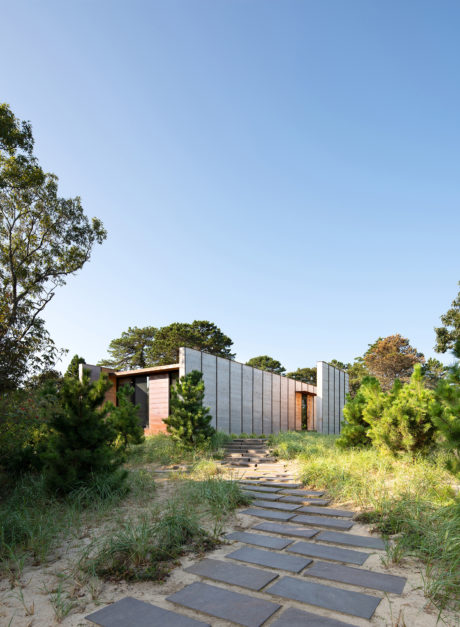
~~~~~~~~~~~~~~~~~~~~~~~
—————– Jurors’ Award / Architecture —————–
Amagansett House | James Merrell Architects
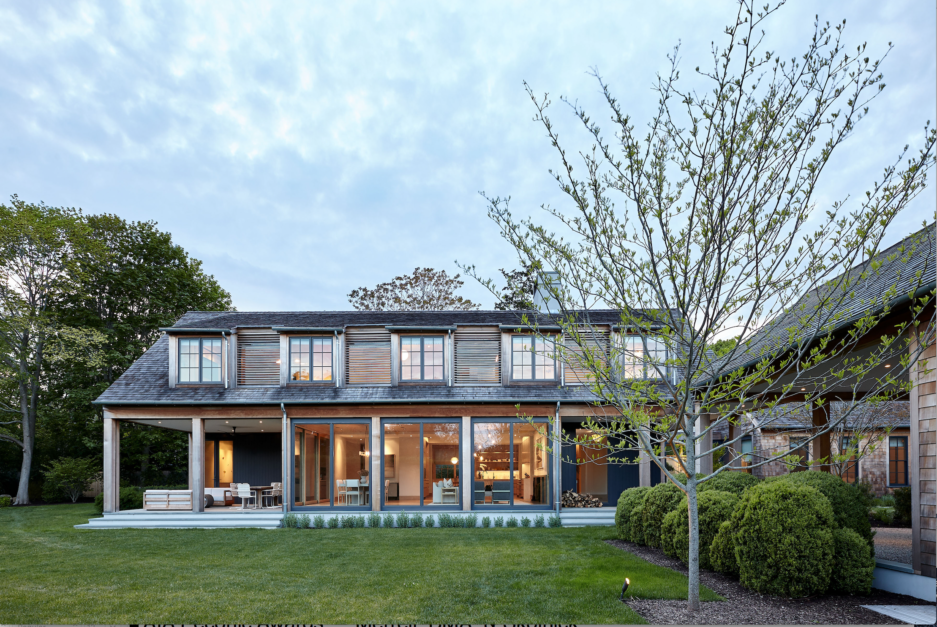
The client, a young family from Manhattan, approached the architects to build a weekend house on a deep, beautiful lot in Amagansett, an idyllic summer destination with a collection of cottages that are walkable to both Main Street and the beach. The Amagansett homes’ low-profiled gabled-roofs, open front yards, proximity to the ocean and village have been sought after for decades. The family had lived on the property in the original house for several years and were ready to create a forever home and a place to escape the hustle of New York City life.
With this project and others, we celebrate the charm and historic character of Amagansett but updated for modern day amenities. In essence, we were tasked with creating a cottage for the 21st century.
The Amagansett House was designed to maintain a modest street facade and situated to stretch east to west to maximize the abundant southern light. The rhythmic dormers running along the roof maximize the light to the second floor, while maintaining more of a cottage scale. Inside, the open floor plan allows for fluid circulation between the spaces, while maintaining a sense of separation, integral to how families want to live today. White oak ceilings help to delineate spaces and a central double height space in the kitchen connects to the second floor hallway.
————————
—– Project Credits Below —–
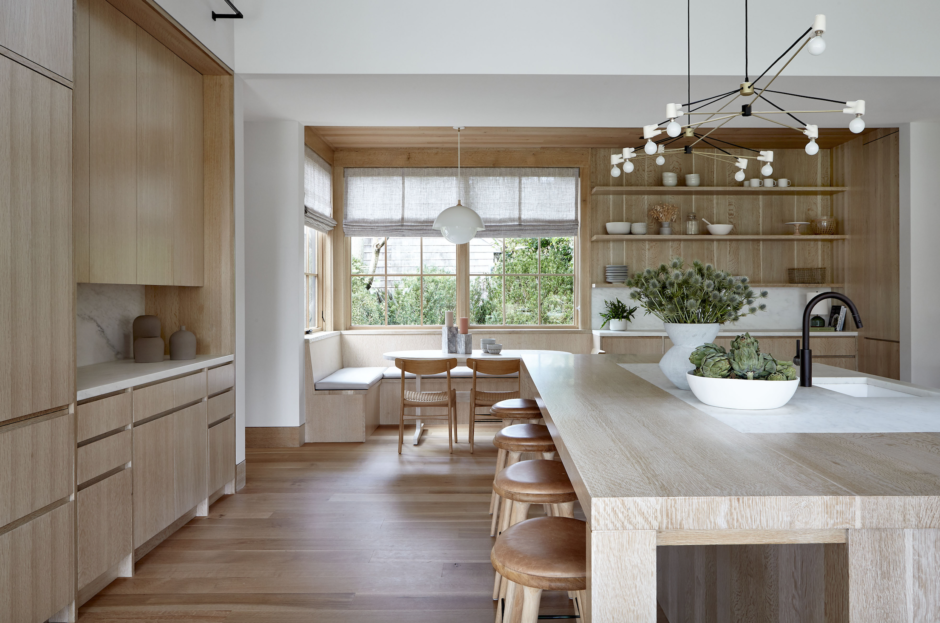
~~~~~~~~~~~~~~~~~~~~~~~
—————– Jurors’ Award / Historic Preservation | Adaptive Reuse —————–
The Church | Skolnick Architecture + Design Partners
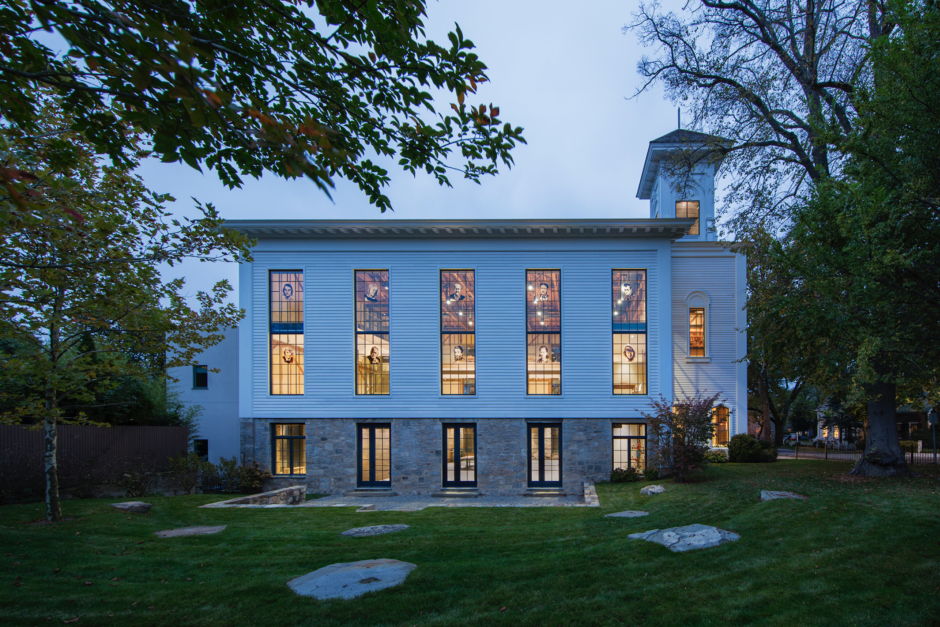
The Church is a comprehensive adaptive reuse and restoration project that returns a once-shuttered Methodist Church, built in 1836, back to the community as a vibrant center for creativity. Developed in close collaboration with the clients, the re-imagined facility features an artists-in-residence program with on-site accommodations, flexible making spaces, exhibition galleries, resource library, and a public garden.
Demolition from prior restoration attempts revealed rustic wood framing throughout, and maintaining this exposure set up a compelling dialogue between past and present, allowing for the sublime geometry of the original structure to emerge in dramatic relief.
Additions to the space are expressed to accentuate their formal integrity while complementing original elements, and a revelation of light-filled volumes and rich material textures characterizes the spatial experience. Portraits of notable East End artists painted by our client, Eric Fischl, have been mounted within the windows of the exhibit space to both welcome visitors and to emanate as illuminated beacons of the community. They present themselves as a modern interpretation of traditional stained-glass windows.
————————
—– Project Credits Below —–
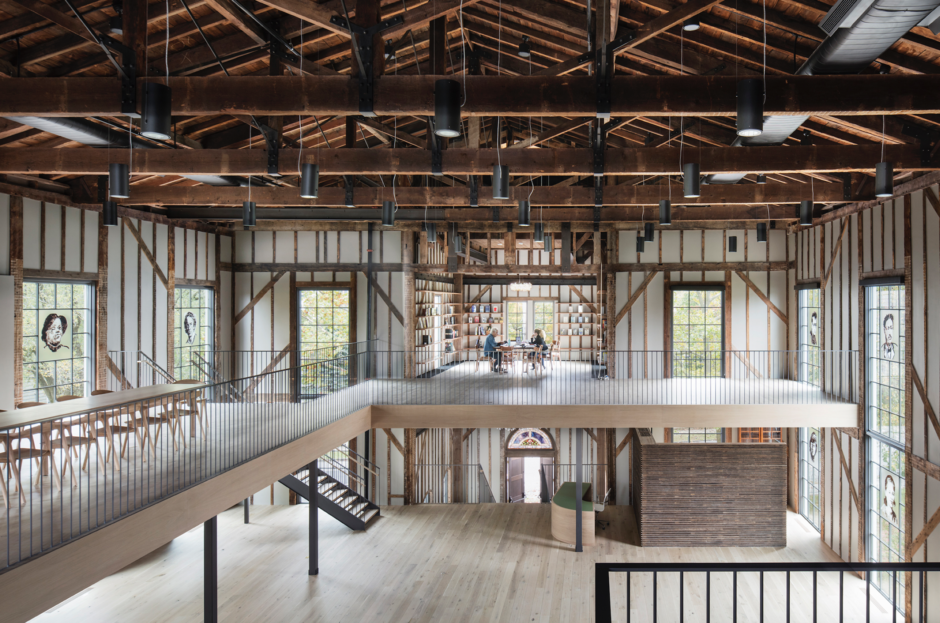
~~~~~~~~~~~~~~~~~~~~~~~~
—————– Juror Award – Unbuilt Projects —————–
Mill Creek Close | BMA Architects
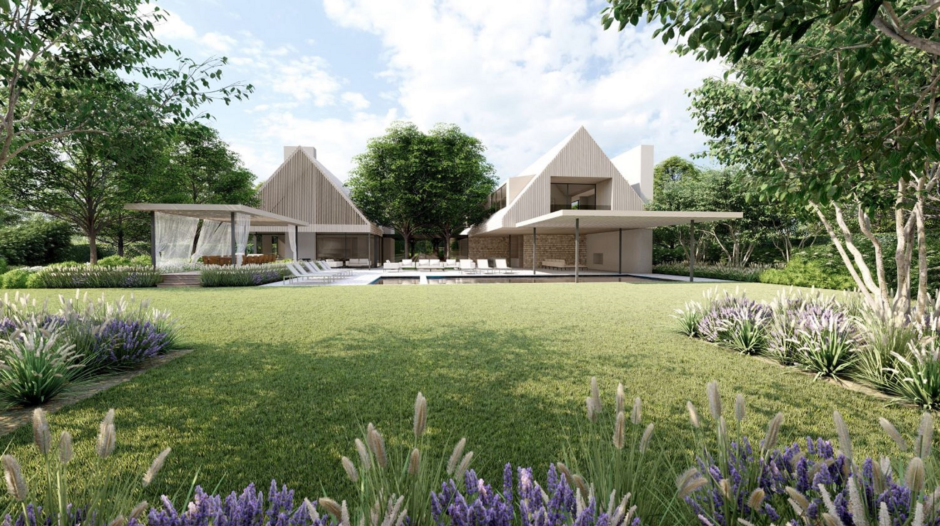
Inspired by its agrarian context, this Water Mill complex features barn-like forms with pitched roofs and cedar shingles in a minimalist play on the local vernacular. A desire to integrate outdoor spaces into the architecture informed the design strategy. The program is divided into two parallel volumes that slip past each other. A glass connector acts as a central hub between the two volumes of the house and links the entertaining courtyards on each side. Per the owners’ directive, outdoor living takes top priority, and a series of outdoor rooms provide generous spaces for lounging, dining, and unwinding at the bar.
At the interior, the gabled form allows for sweeping cathedral ceilings within a grand living space. The pair of volumes establishes distinct programmatic zones, with clusters of public spaces, private spaces, and service cores. At the second floor, one volume houses bedrooms for the family and the other serves as guest quarters.
Neither fussy nor serious, this project serves as a comfortable and relaxed retreat from which to indulge in the pleasures of summer.
————————
—– Project Credits Below —–
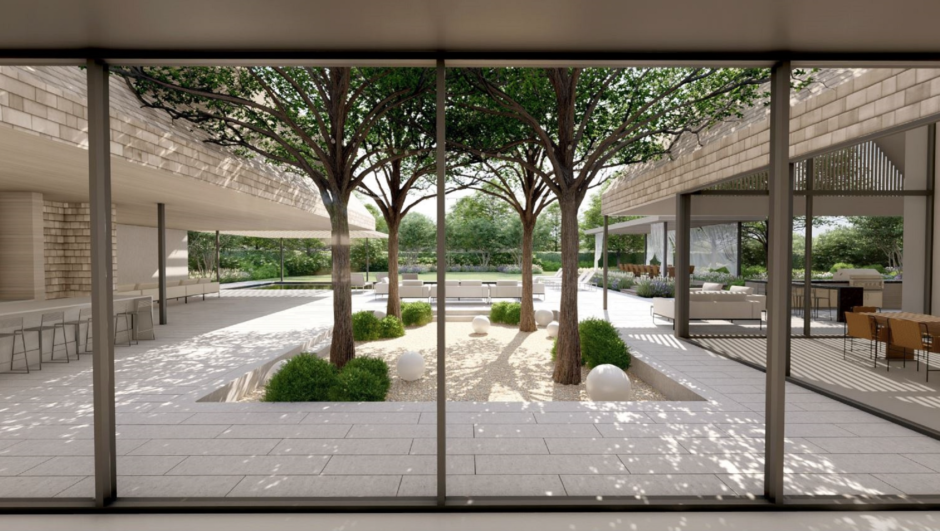
~~~~~~~~~~~~~~~~~~~~~~~~~~~~~~~~~~~~~~

2022 AIA Peconic Jurors
Ameet Hiremath AIA — DEBORAH BERKE PARTNERS
Ameet Hiremath leads academic and cultural projects, as well as residential projects, at Deborah Berke Partners. His projects balance complex uses with environmental sensitivity. Ameet played a critical role in the design of the Cummins Indy Distribution Headquarters, led the design and construction for the 122 Community Arts Center, and is leading the design of our project for Harvard Law School. Ameet earned a Bachelor of Environmental Design from the University of Missouri and received his M.Arch. from Yale University. He joined Deborah Berke Partners in 2006 and became a partner in 2019.
—–
John Keenen — KEENEN/RILEY Architects
John Keenen studied art history at Georgetown University and received his Masters of Architecture Degree from Columbia University. Along with Terence Riley, he founded K/R in 1984. He has twice been the recipient of a Graham Foundation Grant and has twice been a finalist for the prestigious Andrea Palladio Award for Architecture. Since the early 1990’s he has headed K/R’s New York City office. In addition, John is a former trustee for the Design Trust for Public Space in New York City. John has taught as a visiting professor at the University of Texas at Arlington and Austin, Harvard GSD, Rhode Island School of Design, Parsons School of Design and Syracuse University.
—–
Lindy Roy — ROY STUDIO
Lindy Roy is the founder and principal of Roy Studio, an award-winning design firm. Lindy received an M.Arch from Columbia University and a B.Arch Studies from the University of Cape Town. Lindy has served as adjunct at schools of architecture at Columbia University, Princeton, Harvard, IIT, Cooper Union and Rice University. Published widely, Lindy’s work has been exhibited in museums and galleries and was the subject of a solo exhibition, ROY Design Series 1 at SFMoMA. Her work is also represented in the permanent collections of the Museum of Modern Art in New York, SFMoMA in San Francisco and The Art Institute in Chicago. She is currently engaged in a cross disciplinary collaboration with a neuroscientist exploring relationships between neuroscience and architecture.
———————–
Projects categorized as Architecture, Historical Preservation, Adaptive Reuse, and Unbuilt Projects — nine awards recognizing three levels of excellence in architectural design. Submissions were real or conceptual but required to reflect a solution related to the built environment.
~~~~~~~~~~~~~~~~~~~~~~~~~~~~~~~~~~~~~
PROJECT TEAM CREDITS
——————-
Bates Masi + Architects / STONY HILL
Project Team: Bates Masi + Architects / General Contractor: John Hummel & Associates / Interior Furnishings: JL Hummel Interiors. Photo: Bates Masi + Architects.
—————————————————–
Oza Sabbeth Architects / LILLA LANE
—————————————————–
Martin Architects / TOLAN HOUSE
Project Team: Nick Martin – Principal, John Larmor – Project Manager, Natalia Reda – Interior Designer, 4MA Builders – General Contractor
—————————————————–
Bates Masi + Architects / NAPEAGUE
Architecture: (Principal) James Merrell, (Design Lead) Stephen Soule, (Project Architect) Garrett Wineinger. Builder: Cardel Development. (Project Manager) Greg Barletta. Interiors: Flatiron 27. Landscape Installers: Renner Landscaping.
SKOLNICK Project Team: Lee H. Skolnick, FAIA – Principal, Lead Designer, David Vimont, AIA – Project Manager, Jason Hudspeth – Project Architect, Elizabeth Gressel – Senior Graphic Designer
Collaborating Firms Information
The SEED: Lighting Design; S. L. Maresca & Associates: Structural Engineer/Civil Engineer; Moises Cerdas Builder, LLC: General Contractor; Thomas Lettieri: General Contractor (Prior to Moises Cerdas); F. Michael Hemmer, LS, P.C.: Surveying Services; Hollander Design Landscape Architects: Landscape Architect; Furniture Millworker: Thomas Brokish
www.aiapeconic.org
———————
Visit: AIA Peconic: 2021 Daniel J. Rowen Memorial Design Awards
~~~~~~~~~~~~~~~~~~~~~~~~~~~~~~~~~~~








